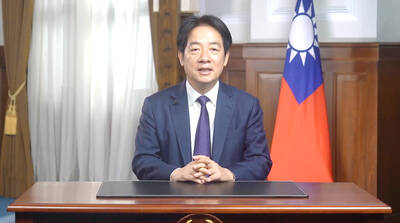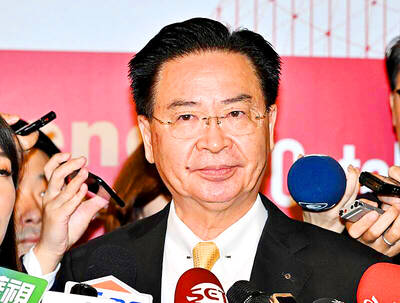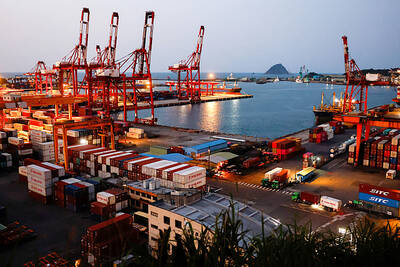On the 22nd anniversary of the US's worst ever nuclear accident -- the Three Mile Island incident -- anti-nuclear activists in Taiwan yesterday released the results of an independent investigation into Taiwan's most recent and worst nuclear accident, the fire at the Third Nuclear Power Plant (
The investigation raised serious questions about the ability of the government's energy departments to handle and prevent mishaps at Taiwan's nuclear power plants.
The fire on March 18 at the plant was triggered in part by transmission problems which occurred on March 17. The malfunction, said to have been caused by a buildup of salt crystals on transmission wires, led to a short circuit that sparked the blaze.
Although the accident caused neither release of radiation nor damage to electrical generators, it was still rated by the Atomic Energy Council (AEC) as the worst of its kind in Taiwan's history.
Activists of the Taiwan Environmental Protection Union (TEPU,
"We doubt that they have been trained professionally because they could not give us reasonable answers," said TEPU Chairman Shih Shin-min (
Activists said that the malfunctions of backup power generators, which caused the fire, should have been avoided.
Wang San-chi (
"The design of electrical systems at the plant is inadequate and the AEC is unaware of the systems' weaknesses," Wang said.
Wang attributed the malfunctions of electrical systems to the AEC's lax regulations.
A report written by Komura Hiroo (
On March 28, 1979, a cooling system malfunction led to a partial meltdown of one of Three Mile Island's reactor cores and caused the release of nearly a million gallons of radioactive coolant water into the nearby Susquehanna River.
A radiation leak alert was broadcast, prompting the evacuation of about 140,000 people from neighboring areas.
The US government spent US$1 billion on a cleanup program following the incident.
The accident brought about sweeping changes involving emergency response planning, reactor operator training, human factors, engineering, radiation protection and many other areas of nuclear power plant operations.
National Science Council Chairman Wei Che-ho (魏哲和), also the leader of a Cabinet task force established to investigate the fire, denied that the design of electrical systems at the plant was at fault.
"If we look at the plant in terms of electrical engineering, its backup power supply systems are sufficient," Wei said.
Wei said that two US electrical engineering professors will join his team this weekend to carry out an investigation at the plant immediately. Wei said that a conclusion would be reached by next Wednesday, when he will submit a report to the premier, Chang Chun-hsiung (張俊雄).

US President Donald Trump yesterday announced sweeping "reciprocal tariffs" on US trading partners, including a 32 percent tax on goods from Taiwan that is set to take effect on Wednesday. At a Rose Garden event, Trump declared a 10 percent baseline tax on imports from all countries, with the White House saying it would take effect on Saturday. Countries with larger trade surpluses with the US would face higher duties beginning on Wednesday, including Taiwan (32 percent), China (34 percent), Japan (24 percent), South Korea (25 percent), Vietnam (46 percent) and Thailand (36 percent). Canada and Mexico, the two largest US trading

ACTION PLAN: Taiwan would expand procurement from the US and encourage more companies to invest in the US to deepen bilateral cooperation, Lai said The government would not impose reciprocal tariffs in retaliation against US levies, President William Lai (賴清德) said yesterday, as he announced five strategies to address the issue, including pledging to increase Taiwanese companies’ investments in the US. Lai has in the past few days met with administrative and national security officials, as well as representatives from various industries, to explore countermeasures after US President Donald Trump on Wednesday last week announced a 32 percent duty on Taiwanese imports. In a video released yesterday evening, Lai said that Taiwan would not retaliate against the US with higher tariffs and Taiwanese companies’ commitments to

‘SPECIAL CHANNEL’: Taipei’s most important tasks are to stabilize industries affected by Trump’s trade tariffs and keep negotiations with Washington open, a source said National Security Council Secretary-General Joseph Wu (吳釗燮) arrived in the US for talks with US President Donald Trump’s administration, a source familiar with the matter said on Friday. Wu was leading a delegation for a meeting known as the “special channel,” the Financial Times reported earlier. It marked Trump’s first use of the channel since returning to the White House on Jan. 20. Citing a source familiar with the matter, the Financial Times reported that Minister of Foreign Affairs Lin Chia-lung (林佳龍) was also a part of the delegation. The visit came days after China concluded war games around Taiwan and amid Trump’s

CHIP EXCEPTION: An official said that an exception for Taiwanese semiconductors would have a limited effect, as most are packaged in third nations before being sold The Executive Yuan yesterday decried US President Donald Trump’s 32 percent tariff on Taiwanese goods announced hours earlier as “unfair,” saying it would lodge a representation with Washington. The Cabinet in a statement described the pledged US tariffs, expected to take effect on Wednesday next week, as “deeply unreasonable” and “highly regrettable.” Cabinet spokeswoman Michelle Lee (李慧芝) said that the government would “lodge a solemn representation” with the US Trade Representative and continue negotiating with Washington to “ensure the interests of our nation and industries.” Trump at a news conference in Washington on Wednesday announced a 10 percent baseline tariff on most goods